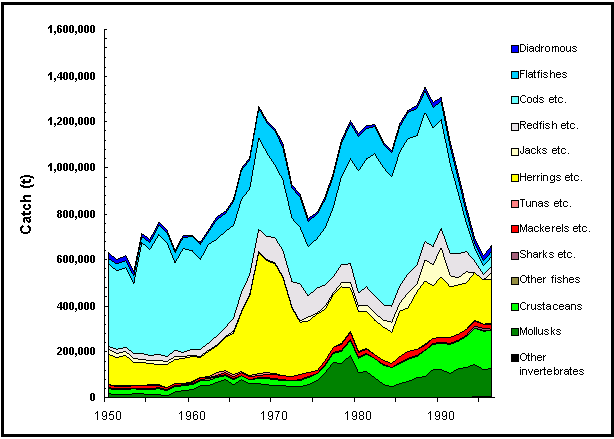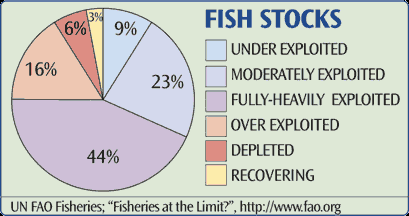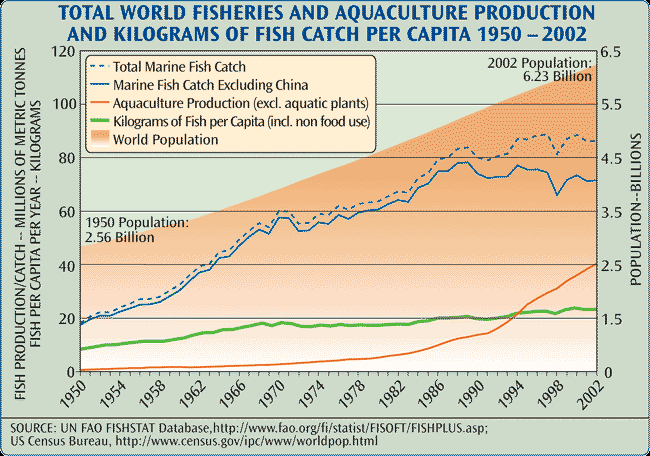Global Fisheries and Environmental Impact, Essay Example
The Current State of the Worlds Fisheries: Global Environmental Impact on the World’s Oceans and the Rise of Aquaculture
Introduction
Fish is a valued food commodity around the world, as it is valued for its high quality of protein. “In 2005, global per capita consumption of fish was estimated at 16.4/kg, with fish accounting for 15.6 percent of the global population’s intake of animal proteins and 6.0 percent of all proteins consumed. Globally, fish provides more than 1.5 billion people with almost 20 percent of their average per capita intake of animal protein, and 3.0 billion people with 15 percent of such proteins. Preliminary estimates for 2007 indicate an increase of the per capita consumption at 17.0 kg.” (fao.org 2007) It is also highly valued due to its high content of omega-3 fatty acids, which are very beneficial to the heart and brain. According to the American Heart Association, fish can be eaten to reduce blood pressure and protect against cardiovascular disease.
According to a theory that is gaining popularity among evolutionary biologists, humans may have descended from primates that lived near the oceans shores some 9 million years ago. This is due to the fact that “our brain and nervous system is built up of long chain omega-3 fatty acids that are found in high amounts only in marine and freshwater organisms.” (eolss.net). Proponents of the theory “postulate that a high intake of the omega-3 acid DHA in the food was crucial for developing the brain capacity of our species in the course of evolution.” (eolss.net). The importance of fish in the human diet continues to be as important today as it was in the past.
The American Heart Association has made recommendations regarding fish. Although it has many benefits, “some types of ocean fish may contain high levels of environmental contaminants such as mercury, PCB’s and dioxins.”(americanheart.org) The world’s oceans today contain high levels of pollutants that make eating wild caught fish more hazardous than in times past.
In addition, the worlds fishing fleets have taken their toll on the ocean’s fish population and have drastically reduced wild fish populations to the point that yearly takes have ended up costing the fishing industry more than the fish were worth. One of the reasons that humans have had such an impact on the oceans’ fish populations is that humans feed two trophic levels higher in the marine food web that in the agricultural one, and 99% of the marine productivity is lost.” (eolss.net). Organisms that are higher on the food chain usually take longer to grow and reproduce. Fish primarily used for aquaculture are at a lower trophic level and grow and reproduce at a faster rate. Aquaculture thus enables humans to harvest fish at a lower trophic level and takes stress off of the marine system.
Aquaculture is not without its drawbacks, but it does contain some solutions to the problems the fishing industry is having today. Current developments in aquaculture are allowing for fish to be grown and harvested with less impact on the environment and for a fraction of the cost as traditional fishing.
Current State of Global Fisheries
There are two ways that fish are harvested commercially. One is through capture, in which fishing boats capture wild fish from the open ocean. The other technique is to raise the fish commercially, in either freshwater commercial pens or in specially built cages in the oceans. This latter technique is called aquaculture.
The FAO puts out a yearly report which gives the data on both fish harvested from commercial farms and those that are wild caught. “The most caught species at the global level is by far the Peruvian anchoveta with about 7.6 million tons in 2007. It is followed in ranking by Alaska pollock, skipjack tuna, Atlantic herring and Chilean jack mackerel. In 2007, catches of coastal and demersal fishes dropped by over 6 percent compared to the previous year, small pelagics grew by 2.5 percent, and tuna and tuna-like species decreased by 1.7 percent after an increasing trend period which led to the historical catch peak in 2006. Global capture production of marine crustaceans and shell mollusks remained fairly stable, whereas total catch of cephalopods (squids, cuttlefishes and octopuses) has continued its constant growth with an overall 35 percent increase during the last 5 years.” (fao.org 2007)
Aquaculture harvests include different species than those captured in the wild. The FAO reports that, “Carps are the most cultured species in the world with 38 percent of production by volume. Other major groups cultured include shellfishes (oysters, clams, mussels and scallops), other freshwater fish (especially tilapias), shrimps and prawns and salmons. At single species level, white leg shrimp generated the highest value (USD 8.8 billion) in 2007, followed by Atlantic salmon (USD 7.6 billion), silver carp (USD 3.6 billion) and other species.” (fao.org 2007)
Environmental Costs of Fishing
Globally, the world’s fish catch has been declining in recent decades. This is due the heavy exploitation of the oceans due to fishing technology like dredging and mile long gill nets that are able to harvest massive amounts of fish indiscriminately. This has led to major fishing collapses that have devastated the commercial fishing industry. One of the most costly collapses in the capture fisheries was the collapse of the cod fishery in the 1990’s. The chart below shows the catch per ton for the Northwest Atlantic fishery, which has traditionally been one of the most profitable fisheries in the world.

Figure 1 Time series catch composition from Canada, Northwest Atlantic. Note collapse of the cod fishery in the early 1990’s. (http://www.fishbase.org/manual/English/fishbasefao_statistics00002679.htm)
Fish stocks everywhere in the world have been depleted and are in a critical state. The world-wide demand for fish led to the development of high tech fishing technology. Huge drift nets and transparent lines combined with large fleets and factory ships increased the amount of fish that were able to be captured at one time. Electronic fish finders and GPS technology made fishing more efficient by locating schools of fish to be captured ahead of time. The “tools and technologies that humans have created allow us to harvest food more efficiently from the sea. These tools in turn made us able to exploit all the major fish stocks of the global oceans.” (eolss.net) “However, the total annual catch has leveled off. The global fishing fleet capacity is nearly double that sustainable supply.” (theglobaleducationporject.org) There is ample evidence today that humans over-exploit the ocean’s fish. The chart below details the percentage of the world’s fisheries that are at different levels of exploitation.

Figure 2 Graph showing declining fish stocks.
“Global total production of fish, crustaceans and mollusks has continued to increase and reached 140 million tons in 2007. While capture production has stayed around 90 million tons level since 2001, aquaculture production has continued to show strong growth, increasing at an average annual growth rate of 6.5 percent from 36.8 million tons in 2002 to 50.3 million tons in 2007. The value of aquaculture production was USD 87 billion in 2007.” (fao.org 2007)
To try to combat this decrease in takes, fishermen are now trying to exploit lower trophic levels in order to meet the demand and increase their profits. Fishing “down the food web” means going after species of fish that are smaller now that the larger fish are not as abundant. Smaller fish reproduce at a faster rate and fishing does not deplete their numbers like it does the larger, higher trophic level fish.
The chart below details the take from both the marine capture fisheries and the aquaculture take. It is clear that as marine catch levels are decreasing, aquaculture is stepping up in production.

Figure 3 Graph showing the decline in capture fishing and a rise in aquaculture.
Capture production has leveled off during the last decade. Despite newer technology, and bigger fleets and nets the total yield of fish captured from the oceans has not increased. “Total global capture production was about 90 million tons in 2007, very much in line with the last decade annual average (90.5 million tons). Reported inland water catch continued its increasing trend with world production exceeding 10 million tons for the first time in 2007, although the statistics for this sector remain highly approximate for many countries.” (fao.org 2007) However, as capture production has leveled off or decreased, “aquaculture production has maintained its steady growth with the average annual growth rate of 6.5 percent for 2002-2007.” (fao.org 2007)
As the world’s population continues to increase, so will its consumption of fish. Fish constitutes a major part of the world’s diet, in some countries more than others. “In 2005, global per capita consumption of fish was estimated at 16.4/kg, with fish accounting for 15.6 percent of the global population’s intake of animal proteins and 6.0 percent of all proteins consumed. Globally, fish provides more than 1.5 billion people with almost 20 percent of their average per capita intake of animal protein, and 3.0 billion people with 15 percent of such proteins. Preliminary estimates for 2007 indicate an increase of the per capita consumption at 17.0 kg.” (fao.org 2007)
Changes have been occurring in the countries that demand higher imports of fish. Countries like the United States did not use to rely heavily on fish as part of its diet. However, recent studies like the ones done by the American Heart Association. As people understand the many benefits that come from eating fish, the demand for fresh seafood has increased. “The United States of America became the major importer of fish and fishery products overcoming Japan, the top importer during the previous 30 years. Aquaculture production is playing an increasing role in supplying fish for human consumption. In 2007, the share of aquaculture production in total fish food supply was estimated at 44 percent.” (fao.org 2007)
Aquaculture
Aquaculture has responded to the demand for increased fish takes by increasing its production of fish. “World aquaculture has grown dramatically in the last 50 years. From a production less than 1 million tons in the early 1950s, production in 2006 was reported to have risen to 51.7 million tons, with a value of US$78.8 billion. This means that aquaculture continues to grow more rapidly than other animal food-producing sectors. While capture fisheries production stopped growing in around mid-1980, the aquaculture sector has maintained an average annual growth rate of 8.7 percent worldwide (excluding China, 6.5 percent) since 1970. Annual growth rates in world aquaculture production between 2004 and 2006 were 6.1 percent in volume terms and 11.0 percent in value terms.” (greenfacts.org)
Aquaculture has many benefits that make it an attractive choice over capture fishing. The implementation of organic standards in the aquaculture industry has been especially beneficial. Organically raised aquaculture fish have lower toxicity levels than wild caught ocean species leading to less risk to consumers. In addition, organic aquaculture benefits the environment by “curbing topsoil erosion, improving soil fertility, protecting groundwater and saving energy.” Organic standards also prohibit the use of genetically modified organisms in the production of fish. GMO technology has been highly controversial in recent times, especially in its use in the aquaculture industry.
Genetic modification in the field of aquaculture has allowed fish farmers to raise fish species more quickly. For example, salmon that are genetically modified can be harvested in a much shorter period of time than their wild cousins. “GMOs continue to be a controversial issue also in aquaculture. Supporters claim that GMOs enhance the performance and profitability of farmed aquatic resources and, hence, improve food security. Opponents argue that they pose significant risks to the environment and, possibly, to human health. While there is universal consensus that GMOs should be regulated, there are disagreements as to what the regulations should contain.” (greenfacts.org)
There are several negative effects from aquaculture on the environment. One of the problems comes from the way in which farmed fish are fed. Marine aquaculture species are raised in pens in inland and coastal waters. They are fed by food pellets that are scattered on the surface and slowly drop through the water column. Not all the food is eaten by the target fish and much falls to the bottom, becoming food for the benthic organisms that live there. This increase in food supply for benthic organisms and other microbes can lead to oxygen depletion from the water. “Many studies have implicated overfeeding in fish farms as the cause of changes in benthic community structure because a high food supply may favor some organisms over others. Moreover, sedentary animals may die in water depleted of oxygen resulting from microbial decomposition, while the mobile population may migrate to other areas.” (csa.com)
Eutrophication is the process by which excess nutrients cause an increase in the primary productivity of the ecosystem. Algal blooms are common in areas surrounding aquaculture pens. Wastes from the fish, as well as excess nutrients from the food, combine to create the ideal living and breeding environment for microorganisms like algae. These algal blooms deplete the oxygen from the water, creating problems for creatures living in the water. “Once the resulting algal blooms die, they settle to the bottom where their decomposition depletes the oxygen. Before they die, however, there is the possibility that algal toxins are produced.” (csa.com)
In addition, there is the issue that farmed fish must be fed a steady diet of wild caught fish in order to replenish their stocks of omega oils. “It can be argued, therefore, that aquaculture cannot provide an alternative to fishing unless only herbivorous fish and shellfish are farmed. However, the source of the fish meal is pelagic fish such as menhaden and mackerel, species not normally consumed by humans. Additional fish meal comes from bycatch which would otherwise be discarded as waste. Nonetheless, it is not clear that the conversion of “trash fish” into human food via aquaculture is preferential to using fish meal in swine and poultry feed.” (csa.gov)
Summary/Conclusion
As the world’s population continues to increase, so too will the worlds demand for fish. In order to meet this demand the fishing industry, both in capture and aquaculture, will need to continue to find new ways of harvesting fish without destroying the environment or exploiting fish populations to the point of collapse. The ocean supports a web a life that exists in a delicate balance with nature. The implications of abusing this resource can be far reaching. The current collapse of the fisheries is telling us that something is wrong. In order for future generations to enjoy the benefits of fresh caught ocean fish, science must find a way to balance the needs of the people with the needs of the ocean’s ecosystems. Aquaculture can be an important part of the solution to this dilemma as long as aquaculture companies strive to maintain a proper balance with the land with their aquaculture practices. It may be possible to restore some balance by farm raising fish from a lower trophic level, thus allowing higher trophic level fish populations to recover in the wild. Humans must also adapt to the stresses of the environment, and that may mean finding different types of fish to harvest. The world’s oceans and the fish that live there play a valuable role in the ecology of the planet as well as the health of humans so we must as a world society address the current situation with the collapsing fisheries and find solutions to correct it.
Literature Cited
Christy, Francis T., Jr. “Marine Fisheries and the Law of the Sea: A Decade of Change” Food and Drug Agriculture Organization of the United Nations 853 1992 9 pages. Print.
Emerson, Craig. “Aquaculture Impacts on the Envrionment.” csa.com ProQuest: Cambridge Information Group, 2010. Web. 21 Apr. 2010.
“Fish and Omega-3 Acids.” Americanheart.org American Heart Association, n.d. Web. 21 Apr. 2010 .
“Fisheries and Aquaculture Department.” fao.org/fishery/en. Food and Agriculture Organization of the United Nations, n.d. Web. 21 Apr. 2010
“Fishing and Agriculture.” theglobaleducatinproject.org Earth: A Graphic Look at the State of the World, n.d. Web. 21 Apr. 2010
Olsen, Y., Endal, A. “Harvesting the Ocean.” Marine Ecology, 2004. Web. 21 Apr. 2010
“Scientific Facts on Fisheries: Latest Data.” Greenfacts.org/en/fisheries Green Facts: Facts on Health and the Environment, 2009. Web. 21 Apr. 2010

Time is precious
don’t waste it!

Plagiarism-free
guarantee

Privacy
guarantee

Secure
checkout

Money back
guarantee






